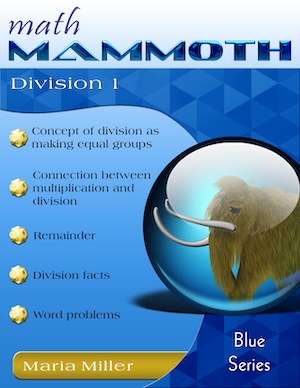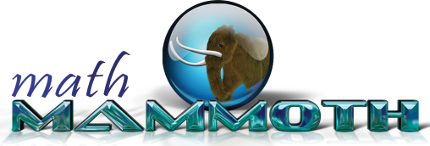Math Mammoth Division 1

57 pages
(answers included)
Sample pages (PDF)
Contents
Dividing Evenly into Groups
Multiplication and Division Fact Families
Multiplication and Division Word Problems
Prices & ordering
PDF download USD $3.60
You will be purchasing the downloads from my authorized reseller Comecero, LLC.
Printed copy $8.65
 Este libro en español
Este libro en español
Math Mammoth Division 1 is a worktext that covers the concept of division, finding whole-number quotients within 0-100 (essentially, the basic division facts), and bar graphs and pictographs. It is most suitable for third grade, after the student knows the multiplication tables.
I recommend the student know the multiplication tables fairly well before starting this book. In fact, the approach taken here to teach division facts is to simply base them on the multiplication tables, and not to teach them as a separate set of facts to memorize. This is very efficient, and works well when the student knows the times tables, but is nearly useless for someone who doesn't know them. Several lessons in the book focus on this basic concept that division problems can be solved by thinking of multiplication.
There are basically two ways to interpret division, and thus to illustrate it with concrete objects. The first way has to do with grouping. The problem 12 ÷ 3 is interpreted as, “How many groups of three items can you make out of 12 items?” This is also called measurement division.
The second way to interpret division is equal sharing: we divide or share items equally between people or other items. For example, the problem 12 ÷ 3 can be interpreted as, “If you share 12 bananas equally between 3 people, how many bananas does each one get?”
Both of these interpretations of division are important to understand so that the student can solve real-life and mathematical problems involving division.
We also study division by zero. In that lesson, students should recognize that division by zero “does not work.” I realize that in higher forms of mathematics, division by zero may be defined (such as 1 ÷ 0 = infinity), but for now, this is how we present it for third graders.
The latter part of the book deals with bar graphs and pictographs. Earlier (in 2nd grade), students have drawn pictographs and bar graphs with single-unit scale. Now, they draw scaled pictographs and bar graphs from the given data, choosing the scale, or how many items one block in the bar graph or one picture in the pictograph signifies. This process provides practice in using both division and multiplication.
Lastly, the book includes an optional lesson on the concept of remainder. It focuses on finding the remainder by using visual models. It is optional because this concept technically belongs to 4th grade.
This book will be relatively easy for students who have mastered the multiplication tables, since division facts are just multiplication tables “backwards”. So, students can focus on another important skill: recognizing real-life situations in word problems that mathematically relate to either division or multiplication. This is very important to master so that the student can later on translate more complex situations into equations (modeling with mathematics).
Like already mentioned, in this book, students will find quotients (answers to division problems) by thinking of the multiplication tables. In continuation (in 4th and 5th grades), they will divide larger numbers, primarily using long division, though thinking of multiplication will still be used for some types of division problems. The basic concept of division is also the foundation for finding factors of a number and prime factorization, which are typically studied in 4th and 5th grades.
You can find free videos covering topics of this book at https://www.mathmammoth.com/videos/ (choose 3rd grade, then division).
The answer key is appended.
The digital version (PDF) of this book can be filled in on a computer or on a tablet using a PDF app with annotation tools.
- Math Mammoth Multiplication 1—a worktext about multiplication concept, word problems, and multiplication tables (grade 3).
- Math Mammoth Division 2—a worktext about long division, word problems, average, and divisibility (grades 4-5).
Better Yet - Bundle Deals!
Blue Series - $165 (download)Blue Series for grades 1-3 - $49 (download)
Blue Series for grades 4-5 - $47 (download)
Blue Series for grades 6-8 - $69 (download)
Light Blue Series, grades 1-8 - $225 (download)
Light Blue Series, grades 1-4 - $112.50 (download)
Light Blue Series, grades 5-8 - $112.50 (download)
All Inclusive Bundle - $275 (download)
"Everything" Bundle - $330 (download)
Learn more about the bundles!
*BONUS*: Buy any bundle listed above, and get the fully upgraded Soft-Pak software for FREE (includes 4 math and 2 language arts programs, complete with on screen and printable options).
How and where to order
You can buy Math Mammoth books at:
- Here at MathMammoth.com website — simply use the "Add to cart" buttons you see on the product pages.
- Rainbow Resource carries printed copies for the Light Blue series books, plus several CDs (Light Blue and Blue series).
- Homeschool Buyers Club offers download versions of the Light Blue series, plus the Blue series bundle.
- Homeschool Planet sells the digital versions of the main curriculum and lesson plans to go with them.
- K5 Learning offers download versions of the Blue series.
- TPT sells the Light Blue Series downloads, plus topical units.
- Lulu sells printed copies for most of the Math Mammoth materials (various series).
By purchasing any of the books, permission IS granted for the teacher (or parent) to reproduce this material to be used with his/her students in a teaching situation; not for commercial resale. However, you are not permitted to share the material with another teacher.
In other words, you are permitted to make copies for the students/children you are teaching, but not for other teachers' usage.
Math Mammoth books are PDF files. I recommend you use Adobe Reader to view them, including if you use a Mac. You can try other PDF viewers, but they may at times either omit or mess up some of the images.
Receive my monthly collection of math tips & resources directly in your inbox — and get a FREE Math Mammoth book!
You can unsubscribe at any time.
Math Mammoth TourConfused about the different options? Take a virtual email tour around Math Mammoth! You'll receive: An initial email to download your GIFT of over 400 free worksheets and sample pages from my books. Six other "TOURSTOP" emails that explain the important things and commonly asked questions concerning Math Mammoth curriculum. (Find out the differences between all these different-colored series!)This way, you'll have time to digest the information over one or two weeks, plus an opportunity to ask me personally about the curriculum. A monthly collection of math teaching tips & Math Mammoth updates (unsubscribe any time) We respect your email privacy.
Note: You will FIRST get an email that asks you to confirm your email address. If you cannot find this confirmation email, please check your SPAM/JUNK folder. |
"Mini" Math Teaching CourseThis is a little "virtual" 2-week course, where you will receive emails on important topics on teaching math, including:
- How to help a student who is behind You will also receive: A GIFT of over 400 free worksheets and sample pages from my books right in the very beginning.We respect your email privacy.
Note: You will FIRST get an email that asks you to confirm your email address. If you cannot find this confirmation email, please check your SPAM/JUNK folder. |
Maria's Math TipsEnter your email to receive math teaching tips, resources, Math Mammoth news & sales, humor, and more! I tend to send out these tips about once monthly, near the beginning of the month, but occasionally you may hear from me twice per month (and sometimes less often). Peek at the previous tips here. You will also receive:
We respect your email privacy.
|
|
